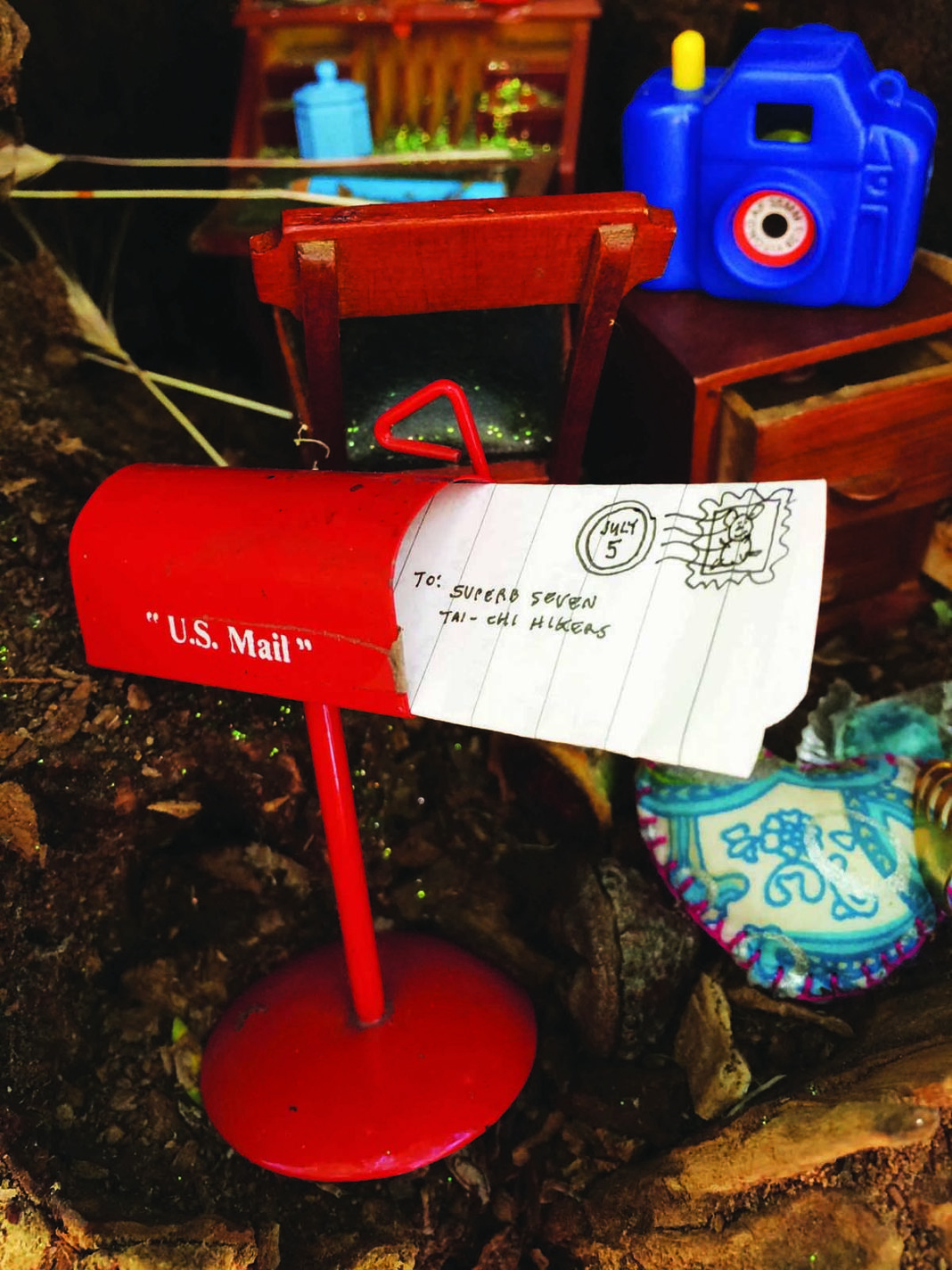Located in the hollow of a tree along the banks of a stream at the Curran Trailhead in Tilden Park, the fairy post office, otherwise known as the Tiny Tilden Post Office, is an intersection of wonder and whimsy that attracts children and grownup hikers alike. It is a miniature post office, about two feet high and one foot wide. It is populated with tiny things. Tiny figurines. Tiny letters. It is an impeccable diorama. When I reach my hand into it, I feel like King Kong.
Lea Redmond of Leafcutter Designs installed the post office as an experiment in December 2013, expecting it would be taken apart by passersby or ravaged by the weather. When she returned to the site a few months after creation, she discovered the post office had expanded; over the months eagle-eyed hikers had left notes and furnished the post office beyond its original design. Instead of perishing, it flourished in the stewardship of others.
This intersection of whimsy and compassion is why I live in Berkeley.
When my mother and I came to tour UC Berkeley in my junior year of high school over 30 years ago, we decided to see the view from the top of the Campanile and made our way up the slope from Sproul Plaza. And then a homeless person stepped onto the elevator with us as the doors closed.
My mother took steps to shield me from what was invisible or frankly, banned, in my suburban LA upbringing. Literal steps. She put her body between me and the person muttering to himself.
That she took steps to protect me was touching. But that there was something against which to protect me, that this new world of living beyond tradition and the possibility of colorfast experiences was within my grasp, exhilarated me. I wanted to see the world beyond manicured lawns and color-coordinated flower beds alongside the patriarchy-informed life checklist of: go to college, go to medical school, get married and have children before the age of 30.
My mother didn’t feel such protective need at Stanford, where the red and white petunias quilted the campus in perfect, half-square triangles. Where the grass looked like a golf course. Where I saw zero litter. Which to many, of course, is a draw.
I made up my mind then to attend Berkeley, no matter what. I emerged with an education beyond my parent’s parameters.
I’ve lived in Berkeley for 30 years now. Being a Berkeley college student and being a longtime Berkeley resident are certainly different things and oftentimes at odds, according to NextDoor and myriad sources. But living in the same town where I went to college feels like living in a time warp; while there have been changes and new buildings have gone up on campus, I only need visit Sproul Plaza or sit on the steps of Wheeler to transport myself to early adulthood. To disappear. To feel forever young.
There are perfect times and places to which we transport—those perfect moments. Nostalgia is forever present here. The roof of Griffiths Hall in the Unit 2 residence hall where I stayed up until dawn speaking with who I thought then was a long-lasting love. The second story of a home on Harper Street where I kissed a woman who told me I was good enough. The slope of Rose Street at Shattuck and feeling the first rush of my beating heart as I bicycled to campus in the morning. Or the time my then-husband broke my heart and so I slid down the concrete slide in Codornices Park in pursuit of five seconds of unfettered joy.
I am raising a daughter in Berkeley. Per the course with humans, her brain rebooted at the age of five and rendered all her concrete memories from early childhood to motes of dust and a lifelong mood. But now that she’s a big kid, her brain has equipped her to remember and curate her memories.
She has had an obsession with fairies and tiny things since she could speak. A visit to the fairy post office was inevitable. It had been in existence three years by then, and it looked like the cutout of a dollhouse, except in a tree. There were tiny action figures alongside tea cups and scribbled notes alongside the more permanent mailbox and furniture.
My daughter was mesmerized. She lived in the world of imagination then; I believed that when she said she saw fairies, she truly saw them, so vivid and detailed were her tellings. The fairy post office was real for both me and for her, an intersection of imagination.
We returned home to retrieve tiny things. And returned to leave them.
Over the years, she has written missives to the tooth fairy and left them there as commemorations for each of her teeth. Once, she left an actual tooth. Another friend said she saw the tooth. My daughter keeps a box of things to take to the post office—a ladybug-sized ladybug figurine, a tiny ice cream cone, the smallest of seashells—in anticipation of future visits.
I didn’t have much wonder in my childhood. I had a good childhood, but imagination was not a large part of my upbringing by immigrant parents. It was dotted by racism and expectations. The town in which I spent the majority of my childhood was a sundown town; we were one of the first non-whites to purchase a home.
I did not know this while growing up, of course. But I grew to expect stares and pointed fingers in a town ironically named Arcadia. I attended potlucks ready to explain the food (mandu, japchae) that my mother had prepared. I had to tell people that I knew what ravioli was, and that Asians did eat ravioli. I had to learn that I was Asian and not Oriental. Later, I learned to curse those who called me “chink” from their vehicles as I walked home from middle school. And to understand that the spray-painted Nazi symbols would be quietly painted over by high school staff, with nary a word to address the hate symbol.
Let’s talk about community here—the sense of safety that community can provide beyond the confines of our homes. To know that we can go to a store on a daily basis without being called a racial epithet. To understand that even the most conservative of Berkeley residents consider social justice in a way that no one in my childhood communities ever did.
At the tiny post office, there are no rules posted.
It is up to those who visit to exhibit their sense of community and respect. The unspoken policy is that you can take what’s there, but it’s expected you replenish the furnishings of the fairy post office. When I get discouraged with the world, I visit the fairy post office and know that people do care. They are taking care of things. Things aren’t pillaged.
The objects in the fairy post office are ephemeral, much like memory. They change according to the imagination and generosity of its visitors. But the tone and the mood remains. A sense of community. Of delight.
What strikes me most about the fairy post office is its permanence. It has stood the test of time and still exists today, nearly seven years later, unlike the handmade Hogwarts sign by the Ashby Avenue exit off of Highway 80 East, which I had hoped would remain longer than the few months it did exist in 2011.
In its permanence, too, the tiny post office has propagated hope and possibility. My daughter and her friends think there are fairy houses and fairy post offices in every park they visit. They seek them out. They find them. And only children can see them; they are invisible to me. The hope for hidden treasure spreads.
I know that one day, she may no longer believe in fairies. That this miniature post office will become a source of amusement rather than a literal portal of imagination. But it existed and on its vacated foundation will spring something founded on the idea of community and imagination. And I know she will search the hollows of trees for the rest of her life.











